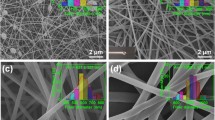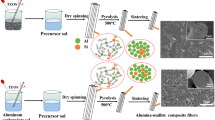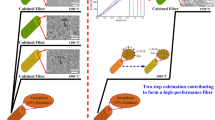Abstract
In the present work, continuous mullite fibers were fabricated through the diphasic sol-gel route using aluminum isopropoxide (AIP) and aluminum nitrate (AN) as the alumina sources and colloidal silica as the silica source. Fiber processing was achieved via draw-spinning method. Amorphous inorganic mullite fibers with smooth and dense features, as well as designed chemical composition and uniform elemental distribution, were obtained by pyrolysis of the continuous precursor fibers at the ending temperature of 800 °C in air. The microstructure and mechanical properties of the samples sintered at elevated temperatures were investigated. Differential thermal analysis (DTA) showed two exothermic peaks at 978 and 1271 °C assigned to the crystallization of γ-Al2O3 and mullite phase, respectively. X-ray powder diffraction (XRD) results verified the typical phase transformation route of diphasic mullite while sintering. Transmission electron microscopy (TEM) and scanning electron microscopy (SEM) showed a rapid grain growth after the mullite phase had formed. As the sintering temperatures increased, the filament tensile strength of the mullite fibers first increased and then decreased, reaching a maximum value of 934 MPa at 1000 °C.

Highlights
-
Continuous and homogeneous mullite fibers were prepared through the diphasic sol-gel route.
-
Alumina sol fabricated by AIP and AN was used to prepare diphasic mullite sol for the first time.
-
Smooth and dense surface remained at 900_1100 °C due to the small γ-Al2O3 grains.
-
Rapid grain growth occurred after 1200 °C was ascribed to the formation of mullite phase.
-
A maximum tensile strength of 934 MPa was acquired after sintering the fibers at 1000 °C.









Similar content being viewed by others
References
Bunsell AR, Berger MH (2000) Fine diameter ceramic fibres. J Eur Ceram Soc 20:2249–2260
Deléglise F, Berger MH, Jeulin D, Bunsell AR (2001) Microstructural stability and room temperature mechanical properties of the Nextel 720 fibre. J Eur Ceram Soc 21:569–580
Schawaller D, Clauß B, Buchmeiser MR (2012) Ceramic filament fibers - a review. Macromol Mater Eng 297:502–522
Almeida RSM, Bergmüller EL, Eggert BGF, Tushtev K, Schumacher T, Lührs H, Clauß B, Grathwohl G, Rezwan K (2016) Thermal exposure effects on the strength and microstructure of a novel mullite fiber. J Am Ceram Soc 99:1709–1716
Schneider H (2005) Basic Properties of Mullite. In: Schneider H, Komarneni S (eds) Mullite. Wiley-VCH, Weinheim, p 141–215
Dong X, Chen Z, Guo A, Liu J, Wang X, Chen C (2018) Mechanical and interfacial behavior of single mullite fiber and mullite fiber-based porous ceramics. Ceram Int 44:14446–14456
Okada K, Yasohama S, Hayashi S, Yasumori A (1998) Sol-gel synthesis of mullite long fibres from water solvent systems. J Eur Ceram Soc 18:1879–1884
Song KC (1998) Preparation of mullite fibers from aluminum isopropoxide-aluminum nitrate-tetraethylorthosilicate solutions by sol-gel method. Mater Lett 35:290–296
Cividanes LS, Campos TMB, Rodrigues LA, Brunelli DD, Thim GP (2010) Review of mullite synthesis routes by sol-gel method. J Sol-Gel Sci Technol 55:111–125
Chen X, Gu L (2009) Sol-gel dry spinning of mullite fibers from AN/TEOS/AIP system. Mater Res Bull 44:865–873
Zhang Y, Ding Y, Gao J, Yang J (2009) Mullite fibres prepared by sol-gel method using polyvinyl butyral. J Eur Ceram Soc 29:1101–1107
Sowman HG (1974) Aluminum borate and aluminum borosilicate articles. US Patent 3,795,524.
Schmücker M, Flucht F, Schneider H (1996) High temperature behaviour of polycrystalline aluminosilicate fibres with mullite bulk composition. i. microstructure and strength properties. J Eur Ceram Soc 16:281–285
Wang Y, Cheng H, Liu H, Wang J (2013) Microstructure and room temperature mechanical properties of mullite fibers after heat-treatment at elevated temperatures. Mater Sci Eng A 578:287–293
Wood TE, Wilson DM (1989) Microcrystalline alumina-based ceramic articles. US Patent 4,954,462.
Richards EA, Goodbrake CJ, Sowman HG (1991) Reactions and microstructure development in mullite fibers. J Am Ceram Soc 74:2404–2409
Song KC (1999) Preparation of mullite fibers by the sol-gel method. J Sol-Gel Sci Technol 13:1017–1021
Chen X, Gu L (2009) Spinnablity and structure characterization of mullite fibers via sol-gel-ceramic route. J Non Cryst Solids 355:2415–2421
Liao S, Bai X, Song J, Zhang Q, Ren J, Zhao Y, Wu H (2017) Draw-spinning of kilometer-long and highly stretchable polymer submicrometer fibers. Adv Sci 4:1600480
Leivo J, Lindén M, Rosenholm JM, Ritola M, Teixeira CV, Levänen E, Mäntylä TA (2008) Evolution of aluminosilicate structure and mullite crystallization from homogeneous nanoparticulate sol-gel precursor with organic additives. J Eur Ceram Soc 28:1749–1762
Beran A, Voll D, Schneider H (2001) Dehydration and structural development of mullite precursors: An FTIR spectroscopic study. J Eur Ceram Soc 21:2479–2485
Ksapabutr B, Gulari E, Wongkasemjit S (2004) Sol-gel transition study and pyrolysis of alumina-based gels prepared from alumatrane precursor, Colloids. Surf A Physicochem Eng Asp 233:145–153
Jing C, Zhao X, Zhang Y (2007) Sol-gel fabrication of compact, crack-free alumina film. Mater Res Bull 42:600–608
Dong X, Liu J, Li X, Zhang X, Xue Y, Liu J, Guo A (2017) Electrospun mullite nanofibers derived from diphasic mullite sol, J Am Ceram Soc 100:3425–3433.
Jiang R, Liu H, Yang L, Sun X, Cheng H (2018) Mechanical properties of aluminosilicate fiber heat-treated from 800 °C to 1400 °C: Effects of phase transition, grain growth and defects. Mater Charact 138:120–126
Borer A, Krogseng GP (1973) Method of firing dry spun refractory oxide fibers. US Patent 3,760,049.
Acknowledgements
We gratefully acknowledge the financial support from the “Chang Jiang Scholars Program” of the Ministry of Education of China (Grant no. T2011119).
Author information
Authors and Affiliations
Corresponding authors
Ethics declarations
Conflict of interest
The authors declare that they have no conflict of interest.
Additional information
Publisher’s note: Springer Nature remains neutral with regard to jurisdictional claims in published maps and institutional affiliations.
Rights and permissions
About this article
Cite this article
Gao, Y., Liu, W., Song, X. et al. Preparation, characterization and mechanical properties of continuous mullite fibers derived from the diphasic sol-gel route. J Sol-Gel Sci Technol 92, 75–83 (2019). https://doi.org/10.1007/s10971-019-05078-0
Received:
Accepted:
Published:
Issue Date:
DOI: https://doi.org/10.1007/s10971-019-05078-0




